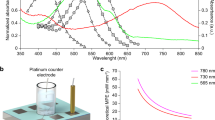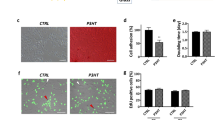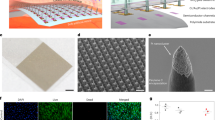Abstract
Interfacing organic electronics with biological substrates offers new possibilities for biotechnology by taking advantage of the beneficial properties exhibited by organic conducting polymers. These polymers have been used for cellular interfaces in several applications, including cellular scaffolds, neural probes, biosensors and actuators for drug release. Recently, an organic photovoltaic blend has been used for neuronal stimulation via a photo-excitation process. Here, we document the use of a single-component organic film of poly(3-hexylthiophene) (P3HT) to trigger neuronal firing upon illumination. Moreover, we demonstrate that this bio–organic interface restores light sensitivity in explants of rat retinas with light-induced photoreceptor degeneration. These findings suggest that all-organic devices may play an important future role in subretinal prosthetic implants.
This is a preview of subscription content, access via your institution
Access options
Subscribe to this journal
Receive 12 print issues and online access
$209.00 per year
only $17.42 per issue
Buy this article
- Purchase on Springer Link
- Instant access to full article PDF
Prices may be subject to local taxes which are calculated during checkout




Similar content being viewed by others
References
Ethier, C., Oby, E. R., Bauman, M. J. & Miller, L. E. Restoration of grasp following paralysis through brain-controlled stimulation of muscles. Nature 485, 368–371 (2012).
Moritz, C. T., Perlmutter, S. I. & Fetz, E. E. Direct control of paralysed muscles by cortical neurons. Nature 456, 639–642 (2008).
Fasano, A., Daniele, A. & Albanese, A. Treatment of motor and non-motor features of Parkinson's disease with deep brain stimulation. Lancet Neurol. 11, 429–442 (2012).
Shannon, R. V. Advances in auditory prostheses. Curr. Opin. Neurol. 25, 61–66 (2012).
Mathieson, K. et al. Photovoltaic retinal prosthesis with high pixel density. Nature Photon. 6, 391–397 (2012).
Zrenner, E. et al. Subretinal electronic chips allow blind patients to read letters and combine them to words. Proc. R. Soc. B 278, 1489–1497 (2011).
Ahuja, A. K. et al. Blind subjects implanted with the Argus II retinal prosthesis are able to improve performance in a spatial-motor task. Br. J. Ophthalmol. 95, 539–543 (2011).
Pastrana, E. Optogenetics: controlling cell function with light. Nature Methods 8, 24–49 (2010).
Mattis, J. et al. Principles for applying optogenetic tools derived from direct comparative analysis of microbial opsins. Nature Methods 9, 159–231 (2012).
Wallace, G. G., Moulton, S. E. & Clark, G. M. Electrode–cellular interface. Science 324, 185–186 (2009).
Owens, R. M. & Malliaras, G. G. Organic electronics at the interface with biology. MRS Bull. 35, 449–456 (2010).
Moulton, S. E., Higgins, M. J., Kapsa, R. M. I. & Wallace, G. G. Organic bionics: a new dimension in neural communications. Adv. Funct. Mater. 22, 2003–2014 (2012).
Bystrenova, E. et al. Neural networks grown on organic semiconductors. Adv. Funct. Mater. 18, 1751–1756 (2008).
Bolin, M. H. et al. Nano-fiber scaffold electrodes based on PEDOT for cell stimulation. Sens. Actuat. B 142, 451–456 (2009).
Abidian, M. R., Ludwig, K. A., Marzullo, T. C., Martin, D. C. & Kipke, D. R. Interfacing conducting polymer nanotubes with the central nervous system: chronic neural recording using poly (3,4-ethylenedioxythiophene) nanotubes. Adv. Mater. 21, 3764–3770 (2009).
Richardson-Burns, S. M. et al. Polymerization of the conducting polymer poly(3,4-ethylenedioxythiophene) (PEDOT) around living neural cells. Biomaterials 28, 1539–1552 (2007).
Gerard, M., Chaubey, A. & Malhotra, B. D. Application of conducting polymers to biosensors. Biosens. Bioelectr. 17, 345–359 (2002).
Arshak, K., Velusamy, V., Korostynska, O., Oliwa-Stasiak, K. & Adley, C. Conducting polymers and their applications to biosensors: emphasizing on foodborne pathogen detection. IEEE Sens. J 9, 1942–1951 (2009).
Simon, D. T. et al. Organic electronics for precise delivery of neurotransmitters to modulate mammalian sensory function. Nature Mater. 8, 742–746 (2009).
Richardson, R. T. et al. Polypyrrole-coated electrodes for the delivery of charge and neurotrophins to cochlear neurons. Biomaterials 30, 2614–2624 (2009).
Wan, A. M. D., Brooks, D. J., Gumus, A., Fischbach, C. & Malliaras, G. G. Electrical control of cell density gradients on a conducting polymer surface. Chem. Commun. 5278–5280 (2009).
Schmidt, C. E., Shastri, V. R., Vacanti, J. P. & Langer, R. Stimulation of neurite outgrowth using an electrically conducting polymer. Proc. Natl Acad. Sci. USA 94, 8948–8953 (1997).
Svennersten, K., Bolin, M. H., Jager, E. W. H., Berggren, M. & Richter-Dahlfors, A. Electrochemical modulation of epithelia formation using conducting polymers. Biomaterials 30, 6257–6264 (2009).
Blau, A. et al. Flexible, all-polymer microelectrode arrays for the capture of cardiac and neuronal signals. Biomaterials 32, 1778–1786 (2011).
Antognazza, M. R., Ghezzi, D., Musitelli, D., Garbugli, M. & Lanzani, G. A hybrid solid–liquid polymer photodiode for the bioenvironment. Appl. Phys. Lett. 94, 243501 (2009).
Ghezzi, D. et al. A hybrid bioorganic interface for neuronal photoactivation. Nature Commun. 2, 166 (2011).
Pappas, T. C. et al. Nanoscale engineering of a cellular interface with semiconductor nanoparticle films for photoelectric stimulation of neurons. Nano Lett. 7, 513–519 (2007).
Goda, Y. & Colicos, M. A. Photoconductive stimulation of neurons cultured on silicon wafers. Nature Protoc. 1, 461–467 (2006).
Kong, L. & Zepp, R. G. Production and consumption of reactive oxygen species by fullerenes. Environ. Toxicol. Chem. 31, 136–143 (2012).
Jacobson, S. G. & Cideciyan, A. V. Treatment possibilities for retinitis pigmentosa. N. Engl. J. Med. 363, 1669–1671 (2010).
MacLaren, R. E. et al. Retinal repair by transplantation of photoreceptor precursors. Nature 444, 203–207 (2006).
Pearson, R. A. et al. Restoration of vision after transplantation of photoreceptors. Nature 485, 99–103 (2012).
Koch, S. et al. Gene therapy restores vision and delays degeneration in the CNGB1–/– mouse model of retinitis pigmentosa. Hum. Mol. Genet. 21, 4486–4496 (2012).
Busskamp, V. et al. Genetic reactivation of cone photoreceptors restores visual responses in retinitis pigmentosa. Science 329, 413–417 (2010).
Bi, A. D. et al. Ectopic expression of a microbial-type rhodopsin restores visual responses in mice with photoreceptor degeneration. Neuron 50, 23–33 (2006).
Zrenner, E. Artificial vision: solar cells for the blind. Nature Photon. 6, 342–343 (2012).
Polosukhina, A. et al. Photochemical restoration of visual responses in blind mice. Neuron 75, 271–353 (2012).
Natoli, R. et al. Gene and noncoding RNA regulation underlying photoreceptor protection: microarray study of dietary antioxidant saffron and photobiomodulation in rat retina. Mol. Vision 16, 1801–1823 (2010).
Valter, K. et al. Time course of neurotrophic factor upregulation and retinal protection against light-induced damage after optic nerve section. Invest. Ophthalmol. Vis. Sci. 46, 1748–1754 (2005).
Delori, F. C., Webb, R. H. & Sliney, D. H. Maximum permissible exposures for ocular safety (ANSI 2000), with emphasis on ophthalmic devices. J. Opt. Soc. Am. A 24, 1250–1265 (2007).
Sliney, D. Exposure geometry and spectral environment determine photobiological effects on the human eye. Photochem. Photobiol. 81, 483–489 (2005).
Butterwick, A. et al. in Proc. SPIE 6426, Ophthalmic Technologies XVII, paper 64260R (eds Stuck, B. E. et al.) (SPIE, 2007).
Acknowledgements
The authors thank M. Nanni, G. Pruzzo and F. Succol for technical advice and M. dal Maschio and P. Baldelli for help with data interpretation and discussions. The authors also thank A.J. Heeger, P. Greengard, L.M. Chalupa and L. Maffei for critical reading of the manuscript. The research was supported by the FP7-PEOPLE-212-ITN (‘OLIMPIA’ grant #316832), the Fondazione Istituto Italiano di Tecnologia (‘Multidisciplinary Projects’) and Telethon – Italy (GGP12033 grant to G.L., F.B. and S.B.). The authors also acknowledge support from M. Monti and by R. and I. Munari Gloder. The manuscript was revised by the American Journal Experts editing organization.
Author information
Authors and Affiliations
Contributions
D.G. prepared cell cultures, degenerate animals and retinal explants, planned experiments, performed photostimulation experiments and cell viability assays, analysed data and wrote the manuscript. M.R.A. planned the experiments, discussed the results and wrote the manuscript. R.M. prepared degenerate animals, performed retinal sections and acquired confocal images. E.L. prepared polymer samples. S.Be., E.L. and N.M. performed polymer-film electro-optical characterization and analysed data. M.M. and G.P. discussed results. S.Bi. discussed electrophysiological experiments with retinal explants. G.L. and F.B. planned experiments, interpreted and discussed the data, wrote the manuscript and supported the research. All authors discussed the results and revised the manuscript.
Corresponding authors
Ethics declarations
Competing interests
The authors declare no competing financial interests.
Supplementary information
Supplementary information
Supplementary information (PDF 1151 kb)
Rights and permissions
About this article
Cite this article
Ghezzi, D., Antognazza, M., Maccarone, R. et al. A polymer optoelectronic interface restores light sensitivity in blind rat retinas. Nature Photon 7, 400–406 (2013). https://doi.org/10.1038/nphoton.2013.34
Received:
Accepted:
Published:
Issue Date:
DOI: https://doi.org/10.1038/nphoton.2013.34
This article is cited by
-
Non-fullerene acceptor based photoelectric material for retinal prosthesis
Micro and Nano Systems Letters (2023)
-
A single n-type semiconducting polymer-based photo-electrochemical transistor
Nature Communications (2023)
-
Multilayered organic semiconductors for high performance optoelectronic stimulation of cells
Nano Research (2023)
-
Bioresorbable thin-film silicon diodes for the optoelectronic excitation and inhibition of neural activities
Nature Biomedical Engineering (2022)
-
Biointerface design for vertical nanoprobes
Nature Reviews Materials (2022)



